Clematis Ernest Markham - full description of the variety
Belonging to the Jacquemann group, Clematis Ernest Markham was bred in 1936. A liana-shaped shrub with large pink-red flowers is now grown throughout the CIS, even in the most northern regions. The variety is unpretentious and durable, capable of blooming in one place without transplanting for more than 10 years.
- Description of the variety
- Landing features
- Organization of the place
- Preparation of planting material
- Technology
- Care
- Watering mode
- Mulching and loosening
- Tying
- Top dressing
- Trimming and shaping
- Preparing for winter
- Reproduction
- Cuttings
- Layers
- Dividing the bush
- Diseases and pests
- Examples in landscape design
- Variety reviews
- Useful videos
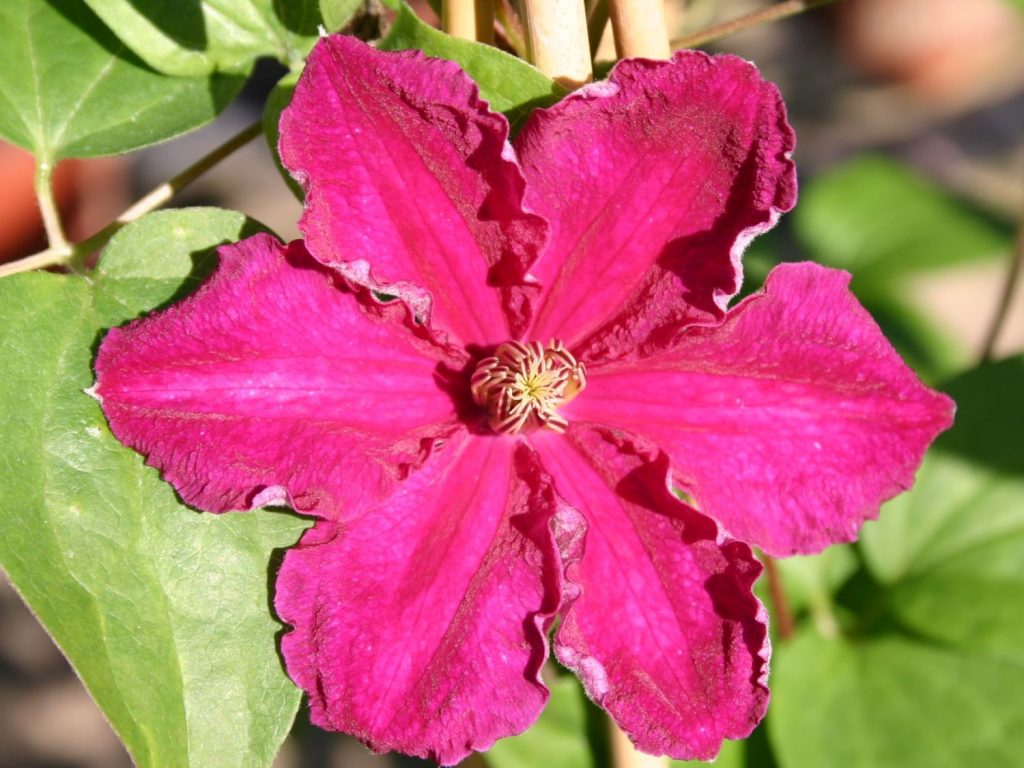
Clematis Ernest Markham photo and description
Description of the variety
The Ernest Markham variety is distinguished by long curly stems up to 5 m and large flowers 12-14 cm in diameter. The stems of the plant allow you to use it as a hedge, design a gazebo, decorate fences and walls. Without pruning, vines can be very long and branched, but they are usually pruned without growing more than 3 m.
The leaves are elongated, pointed and ovoid. Each of them consists of 4-5 small leaves up to 12 cm long and 6 cm wide. The surface is smooth, the edges are wavy. Leaves are glossy with a dark green tint. They keep on the shoots with the help of elongated petioles, which allow them to cling to any support. The root system is powerful, the main long and dense taproot has many branches. Some of them reach 1 m.
Clematis flowers have 6 petals, slightly curved at the edges. They are purple-red, with creamy large stamens. Each liana blooms 2-3 buds, the whole bush looks very decorative. The diameter of each bud is up to 14 cm, which is quite a lot for clematis. It blooms for the first time in July-August, the second time in September-October.
Landing features
All clematis tolerate autumn planting better. In the spring, all forces immediately go to the stems and leaves, and the root system lags behind in development. In addition, the threat of frost persists in the spring, and this is dangerous for an immature seedling.
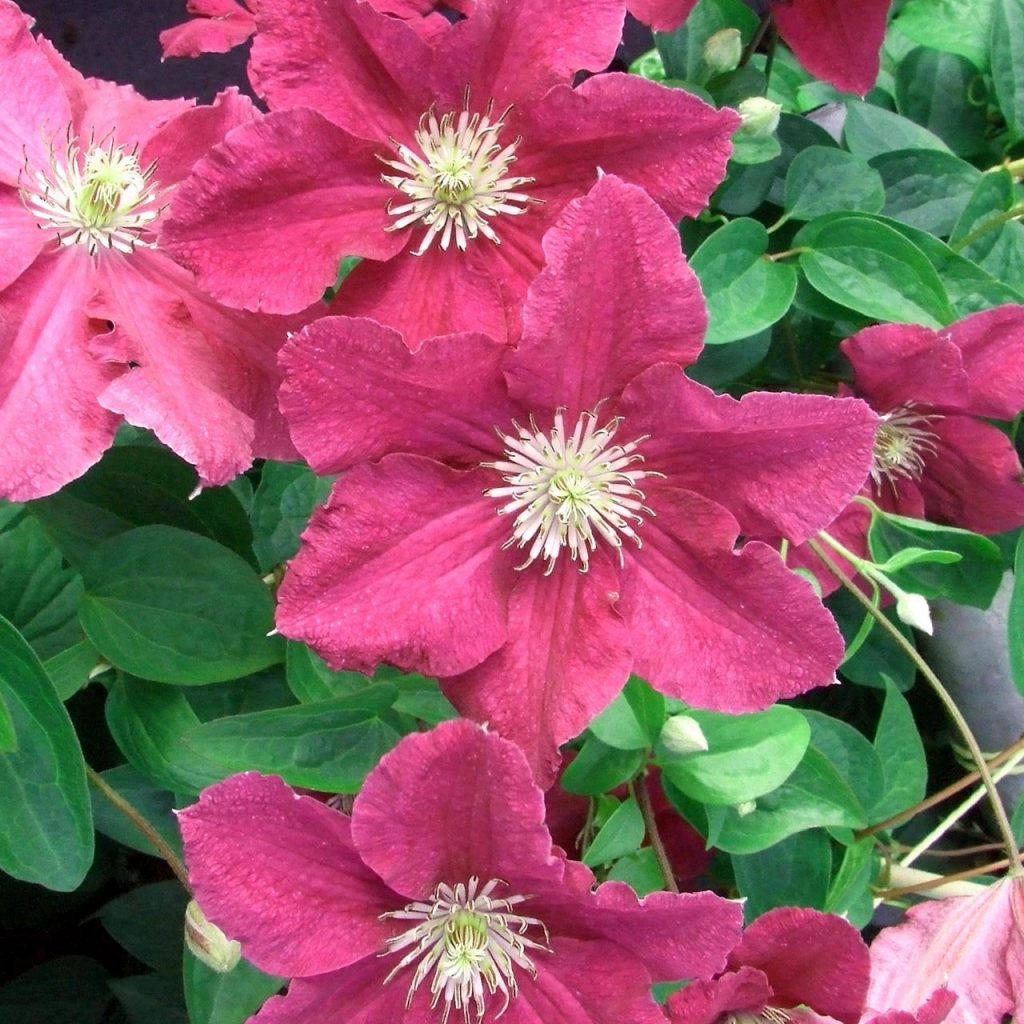
Clematis Ernest Markham photo and description
In autumn, the temperature is lower, but more stable, there is more moisture, the plant has time to adapt, and then leave during the dormant period.
Organization of the place
The planting site is prepared for the bushes in advance, since the summer. Clematis loves good lighting and warmth, as well as the absence of drafts. The southern side of the site, where the plant will be protected by a wall or a large tree, is ideal. In shady places, clematis will grow poorly, wither and die sooner or later.
The soil should be loose and light, mostly sandy, fertile. Clay or acidic areas will not work.
With a strong desire to have clematis, it is allowed to plant it on any soil, but then you will have to artificially bring it to the desired parameters. It is troublesome, costly and without any guarantees that the plant will take root and grow.
A hole is dug two months before planting. If spring planting is supposed, then it is prepared from late autumn. The dimensions of the pit are 60x60, the depth directly depends on the occurrence of groundwater.It is undesirable to plant clematis where the waters are closer than 2 m from the surface.
But if there is no other place, then you need a hole 1 m deep and a drainage layer at its bottom of at least 40-50 cm.It can be red brick, clay shards, stones, gravel - anything that will not allow water to stagnate at the roots.
Preparation of planting material
It is important to pre-inspect purchased seedlings and, if necessary, treat them with preparations against fungus and pests. Choose only a healthy plant so that it takes root well and does not infect other garden crops.
It is not necessary to process self-grown seedlings, but only the strongest of them should be placed in open ground. They must have at least 5 roots no shorter than 25-30 cm. A weakened plant will not be able to gain strength for lush growth and flowering, it will lag behind in development from the rest. Before planting, it is better to place all plants in a liquid growth biostimulator for 5-6 hours.
Technology
Nutrient soil is poured onto the pre-laid drainage layer. Clematis variety Ernest Markham is picky about the composition of the soil. He needs a lot of nutrients and minerals and organics. Usually the following soil mixture is prepared: leaf humus, fertile soil, ash, dry compost. All this is mixed and poured into the pit.
Place the seedling on a mound of soil, straighten the roots. A support is dug in nearby so that the root system is not damaged. Sprinkle the seedling with the remaining soil and trample. The root collar must be buried in the ground, unlike fruit tree seedlings. At the end of planting, the plant is watered with settled (preferably rain) water.
Attention! Clematis Ernest Markham is always planted deep. The larger the bush, the deeper it is placed in the pit. This is done to prevent the roots from drying out and overheating.
Care
The variety requires good maintenance for long and abundant flowering. This is not a plant that has been planted and forgotten. Everything from watering to pruning and sheltering for the winter needs to be done according to a certain pattern. This is the only way to achieve an excellent result in growing this exotic plant.
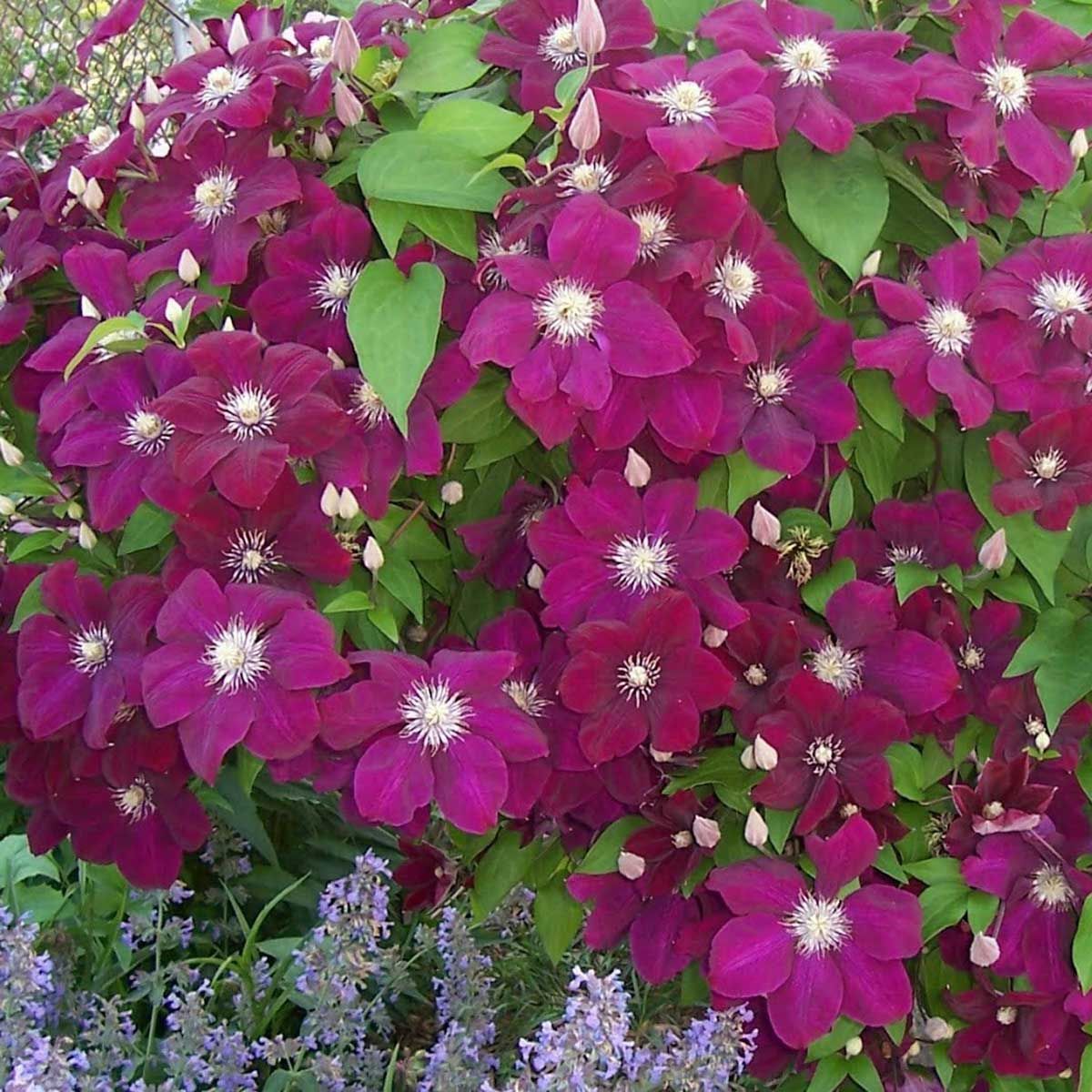
Clematis Ernest Markham
Watering mode
Watering in the summer should be 2-3 times a week, in the evening, after the heat subsides. At temperatures above +27 ° C, watering should be increased by making it daily.
When planted correctly, with good soil and a layer of drainage, the roots will be safe.
Young seedlings should be watered with warm, settled water. When planting a plant under the roof of a house, you should make sure that water does not drain onto the bush during rain. This will lead to waterlogging of the roots and the death of the culture.
The amount of liquid when watering depends on the size of the bush. A newly rooted stalk will require 2-4 liters of water, and an adult plant will need at least 10 liters.
Mulching and loosening
Overheating of the ground in the root zone is detrimental to all types of clematis. To avoid this, the soil around the trunk is mulched with various materials - sawdust, chopped wood, dry compost. Use for these purposes leafy earth or humus, but dry, rotted.
All the weeds are preliminarily weeded out, because under a warm "fur coat" they will grow even more actively, drawing life-giving juices from the plant. The layer of mulch should be 15-20 cm. After each watering or heavy rain, this layer is loosened to ensure the flow of air to the roots of the plant.
Instead of mulching, you can simply plant low annuals around the bush. They will protect the roots from overheating, while some of them are even capable of repelling insect pests. For example, marigolds, calendula or nasturtium will do just fine with this task. After wilting, these flowers, rotting, will provide additional nutrition for the bush.
Tying
The Ernest Markham variety requires a garter only at the initial stage of shoot growth. They must be directed to the support and tied to it, then powerful and tenacious vines themselves will fix themselves on the protrusions and irregularities.As the stems grow, it is important to ensure that they are securely attached. For fidelity, it is better to tie the vines in several places.
During a strong wind, there is a risk of the stems breaking off from the support, or even the fall of the entire bush. The plant can be severely damaged in this case. It is better to take care in advance to securely fix the lashes on the arch, wall or net. Tied up shoots are better illuminated by the sun and bloom more abundantly.
Top dressing
The first year after planting, the soil is supplied with all useful substances. It is not worth adding them additionally - overfeeding is harmful to a young plant. In the second year, clematis begins to fertilize in early spring. After winter dormancy, the flower needs nitrogen for the growth of shoots and leaves. Use a solution of mullein or poultry droppings in proportions 1:10 and 1:15.
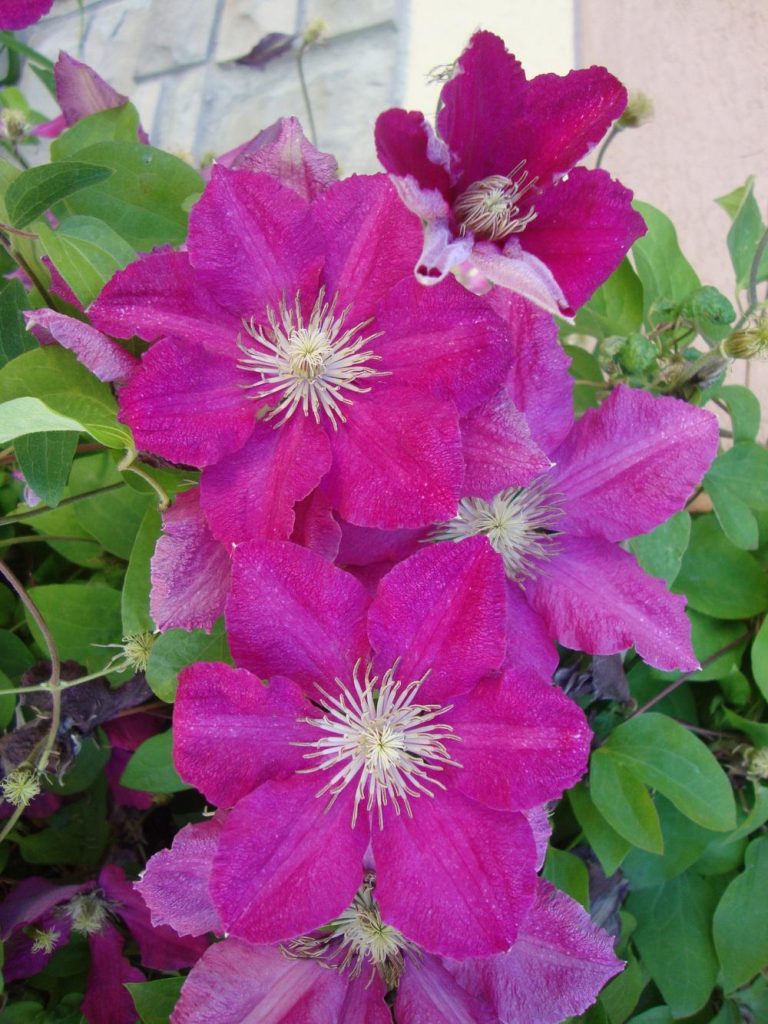
Ernest markham clematis
Young foliage can be fed by the foliar method - by spraying with a urea solution: 3 g per liter of water will be enough. The procedure is performed once in May. Also at this time it is useful to nourish the bushes with a solution of lime: dissolve 150 g in 10 liters of water and pour it under the root.
During the budding period, clematis needs phosphorus and potassium. Superphosphate and potassium sulfate are essential substances .. You can take ready-made mineral complexes - Riga mixture, Nitroammofosku or Kemira lux. At the end of summer, nitrogen is no longer fertilized, but phosphorus-potassium fertilizers are applied.
During the growing season, clematis is sprayed several times with a solution of manganese and boric acid (2 g per bucket of water). This will serve as both feeding and disease prevention.
Folk remedies have proven themselves well:
- Tea brew and coffee cake. These products contain many nutrients useful for the plant, improve the structure of the soil. They are not just poured under the bush, but added to the topsoil for a better effect.
- Onion husks. 20 g of dried husk is poured into 5 liters of water, boiled for 1 minute, covered with a lid and left to infuse. After 4-5 days, the useful infusion is ready. It can not only be poured under the bush, but also sprayed on the leaves.
- Wood ash. It is a valuable source of micronutrients. 2 l of the substance is diluted in 5 l of water, stirred and infused. In the future, 1 liter of infusion is dissolved in a bucket of water and watered with clematis.
- Potato broth. It contains not only starch, but also trace elements necessary for all flowering plants. The main advantage of such feeding is that it cannot be overdose, it has no side effects.
- Decoctions of herbs. The most valuable is nettle broth. The green mass is cut and placed in a bucket, filled with water. In a warm place, the infusion begins to ferment, foam appears. After 1.5-2 weeks, fertilizer for clematis is ready.
Trimming and shaping
The Ernest Markham variety belongs to the III pruning group, when all the shoots are completely removed from the plant in late autumn. A stump 10-15 cm high with several living buds is left above the ground.
Before the first winter, the main stem of a young plant is cut off higher - by 20-25 cm, so that more lateral shoots are formed next year.
It is also important to form a bush by pinching the tops of the vines and provoking the appearance of new shoots. The more there are, the more lush flowering the bush will delight. In the first years, it is better for clematis not to bloom profusely, breaking off all the buds. So the plant will form a powerful root system, strengthen and, in the future, will bloom luxuriantly and for a long time.
Preparing for winter
A few months before the arrival of winter, the plant is no longer fertilized with nitrogen. This reduces the growth of green mass, strengthens the roots and strengthens the immune system. So clematis will more easily endure frosts, although good shelter will not hurt him either. To begin with, mulch near the trunk is sprayed with fungicides and mixed with ash. This will prevent the development of fungus in it.
Then wooden boxes are built, which are then covered with the cut plant column. A layer of dry foliage is poured on top and covered with spruce branches. Roofing material is added if it is a northern region and frosts are expected -35 ° C and below.Clematis survives such winters without any problems.
Reproduction
Clematis is easy to propagate in several ways, each gardener will choose the most suitable one for himself. The main thing is to take planting material from an adult healthy bush without damage and pests.
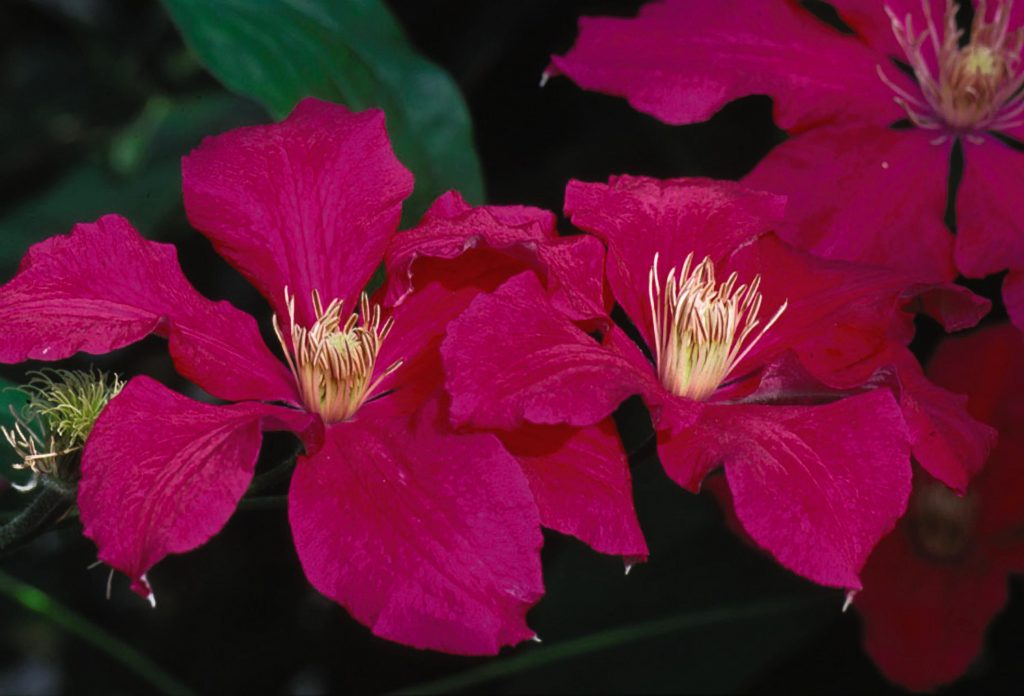
Clematis Ernest Markham reviews
Cuttings
Clematis is cut in the spring, at the beginning of May, when young shoots begin to grow. It is advisable to cut the liana into cuttings even before the leaves are completely blooming - this will be a greater percentage of successful rooting. Each stalk should contain 2-3 buds, up to 10 cuttings can be obtained from one liana.
Root them either in water or directly in the substrate. Water is an easier and faster option, but later, during planting in the ground, the stalk may not take root.
When planting directly into a nutrient substrate, the rooting percentage is lower, but the young seedling will not be stressed during transplantation.
Cuttings are rooted in a mixture of perlite and vermiculite. It is a light, loose, nutritious composition in which absolutely all plants - from succulents to epiphytes - take root easily.
The clematis is placed in a substrate and covered with a jar. In a warm and bright place, rooting takes place after 2-3 weeks. After another two months, he is ready to be transplanted into the open ground.
Layers
This method is the most reliable. At first, young shoots are inseparable from the mother bush, which increases their survival at times. The reproduction technology is simple - one or more shoots of clematis are bent to the ground and instilled so that the tip sticks out. The place of placement in the ground is periodically watered.
The roots are formed after a month, but you cannot immediately separate the stalk. Throughout the warm season, it is in conjunction with the mother bush, receiving additional nutrients from it. The main stem is cut off only before winter, when the plant has already plunged into a state of dormancy. From spring, when the young bush grows, it must be transplanted to another permanent place.
Some gardeners advise not to separate the layers in the first year, leaving them to winter in conjunction with the main bush. In the spring, when the plant wakes up and grows, it will be seen whether the layers have taken root.
They are separated already in the summer, before the budding of the main bush, so that it does not waste energy on them. With this method of reproduction, young clematis bloom the next year after separation and transplantation to a new place.
Dividing the bush
This is not so much a breeding method as it is the rejuvenation of an adult plant. The Ernest Markham variety is prone to strong growth, so the bush needs to be thinned from time to time. In a thickened plant, the formation of buds worsens, growth slows down and immunity drops sharply.
- The sparing method is simple: a part of the bush with a separate growth point and several shoots is cut off from the main bush with a sharp shovel. This is already an independent plant, which, when planted in a new place, will bloom the next year.
- The radical method is suitable for very old clematis bushes - over 15 years old, for which gentle thinning no longer helps.
The plant is dug up, shaken or washed off the soil from the roots to make it easier to divide the bush. Usually, the division process is simple - clematis easily breaks up into small bushes. Each of them is a separate plant that can grow in a new place. Up to 20 smaller ones are obtained from one old bush. The maternal, oldest, central plant, as a rule, does not survive after such a procedure.
Diseases and pests
The Ernest Markham variety is susceptible to all kinds of rot. Most often, the plant gets sick with the wrong shelter for the winter. Its roots survive from excess moisture, and a harmful fungus develops in them. In this case, saving the plant is difficult, but possible. The bush is dug up, the roots are dipped in a solution of a powerful fungicide, then placed in a new dry soil, sprinkled with ash.
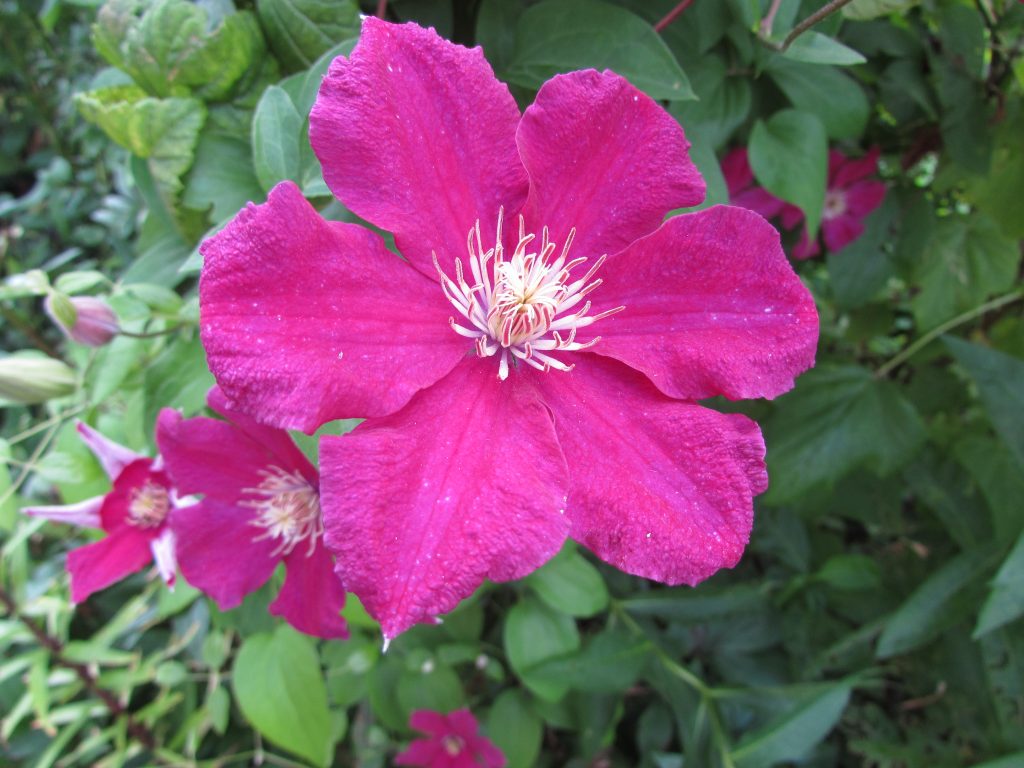
Clematis ernest markham
Fusarium and wilt are no less frequent diseases of this variety.Caused by different types of fungi that are recognized by symptoms. If, for example, the bush sharply loses its turgor and withers, and brown tubercles are visible on the stems, this is the action of the Phomopsis Demissa fungus. If the stem turns black below, and the bark swells at the site of the lesion, then this is Fusarium.
The most effective in this case is the drug Switch, which includes cyprodinil and fludioxonil. Processing is carried out twice with an interval of 10-12 days. For prophylaxis in spring and autumn, it is recommended to spray clematis with a 3% solution of copper or iron vitriol. Before flowering, Trichodermin is mixed into the topsoil.
Nematodes are the most dangerous pests. These micro worms, settling in the roots, are capable of destroying an adult plant in a short time. There is no escape from them, the affected bush is burned.
Clematos are also affected by spider mites, aphids, bears and slugs. The first two can be dealt with with insecticides, the last two are destroyed by hand. The most effective insect repellents are Antiklesch, Fitoverm, Biotlin, Aktara, Akarin. Treatment is needed twice, at an interval of 10-14 days.
For slugs, ammonia will help (2 tablespoons per 1 liter of water). Ferramol is also scattered around the bush on the ground. He will not allow pests to get to the clematis. From folk remedies, lime and crushed egg shells help.
Examples in landscape design
Clematis are the best plants for decorating the site. They can be used both singly and in combination with other ornamental crops. Having picked up several species with different budding times, it is easy to create a "flowering conveyor" in the garden.
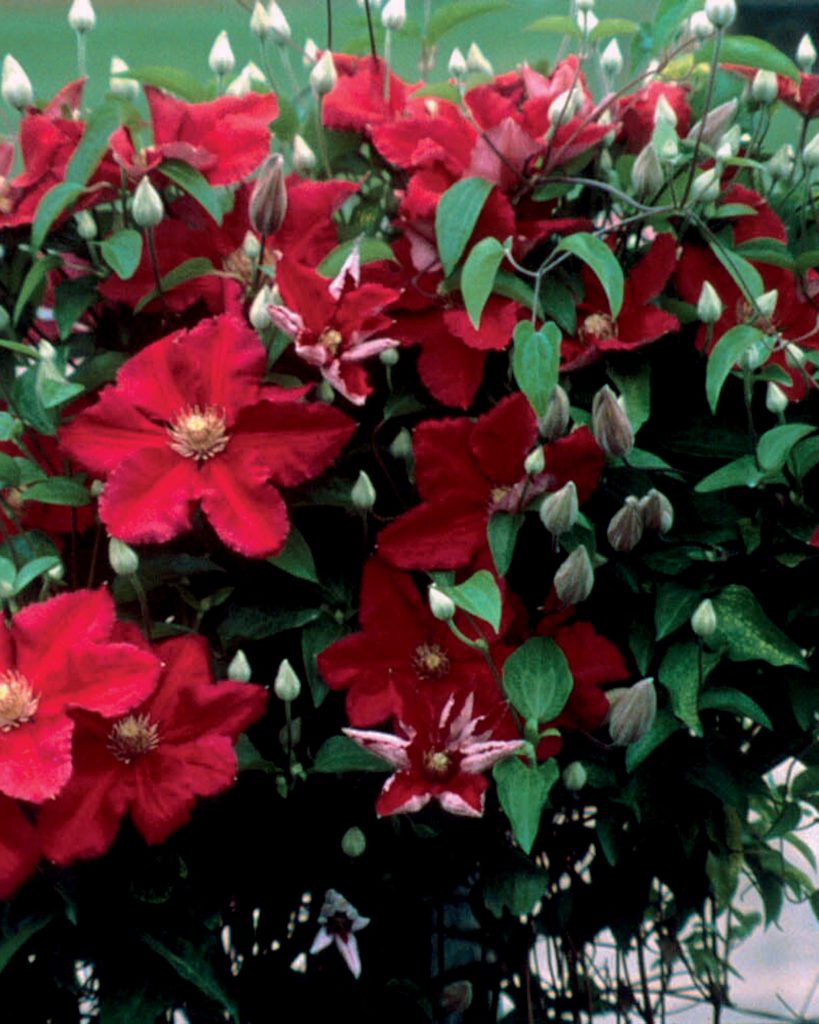
Ernest Markham Clematis
The Ernest Markham variety, as a large-flowered one, is often planted separately. They are used to decorate trellises, arches, gazebos, pergolas, and house facades. Supports are arranged in the form of an umbrella, stele, pyramid, trellis. Such structures in the garden are always visible, so clematis will be in sight. The main thing is that the composition fits into the surrounding landscape.
Large-flowered clematis look good next to climbing roses. For example, David Austin's roses will perfectly complement Ernest Markham's clematis. A gazebo decorated with these flowers will look as decorative and harmonious as possible.
Lianas are also combined with girlish grapes, climbing honeysuckle, hydrangea, lemongrass and such a rare plant as Albert's mountaineer. They can beautifully decorate trunks of dried trees, gazebos and facades. The main thing is that the support under the clematis is higher than the bush itself. Otherwise, the shoots, reaching the top, will become confused and stick out in different directions. The composition will lose its decorative effect.
Variety reviews
This variety collects only positive reviews from gardeners. For all its beauty and unusualness, it is completely unpretentious. The third group of pruning allows you to cope with this procedure even without much experience. Sheltering a bush for the winter is also not a problem.
For those who like to propagate clematis by seeds, the Ernest Markham variety is not suitable. It is hybrid, which means that it does not retain varietal properties during seed propagation. But it is easily cuttings, a new young plant is formed in a few months.
Gardeners from the northernmost regions note the exceptional winter hardiness of the variety. Even at -35 ° C frost, the plant survives under a layer of snow. It was even noted that the more frosty the winter was, the more magnificently clematis bloomed the next summer.
Ernest Markham is becoming more and more popular every year. This large-flowered hybrid is not in vain considered one of the best clematis breeding results. Due to its endurance and unpretentiousness, it is grown all over the world as a garden decoration and decoration of the local area.

